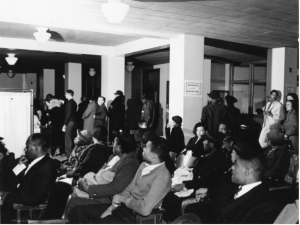
The research project began by focusing on Duke University’s Physician Practice Plan, the Private Diagnostic Clinic (PDC), and how its formation and functioning from 1930-70 influenced the provision of segregated health care at Duke. The scope of the research expanded when it became clear that the Duke School of Medicine, the Duke hospital, and the PDC cannot be meaningfully separated — they were three legs of a stool whose goal was to create a world-class medical enterprise in the American South, at Duke University. The School of Medicine was founded in 1927 and welcomed students in 1930, after the hospital opened in 1930. The PDC was founded in 1931. Three key physician leaders, Wilburt Davison, Deryl Hart, and Fredric Hanes, were the primary architects of Duke’s remarkable rise to prominence, that improbably began in the grips of the Great Depression.
Our research tells a story of tension between the academic mission to train physicians for North and South Carolina in cutting-edge scientific medicine, the expense and difficulty of achieving this goal, and differential treatment by race as an ever-present reality across our study period that spans Jim Crow to the Civil Rights Act and creation of Medicare and Medicaid.
We note several key findings:
- The coordinated influence of the three physician architects of the Duke University School of Medicine, Duke Hospital, and the PDC — Wilburt Davison (founding Dean, Pediatrician), Deryl Hart (Chair of Surgery and co-founder of PDC), and Fredric Hanes (Chair of Medicine and co-founder of PDC) is difficult to overstate.
- Duke launched its Medical Enterprise at a difficult time — the Great Depression — and neither its financial viability nor was the level of excellence, as seen today, was guaranteed. Financial survival was the predominant issue facing Duke’s medical enterprise, especially during the first half of our study period (1930-50).
- Duke Hospital opened on July 21, 1930 with separate White and Colored wards. This was unusual because most segregated hospitals became so by adding Negro wings after their opening. We found little explicit discussion of why Duke so opened, but regardless of the intent, the architects of Duke’s Medical Enterprise (School of Medicine, hospital, and the PDC) embedded differential treatment by race into its ethos from the beginning. One result is that generations of Black patients have experienced differential care at Duke due to their race.[1]
- The language of race was mapped onto Public versus Private care provision during the study period, a process that was reinforced by the rise of 3rd party health insurance that began in the 1940s with employer-sponsored insurance, and accelerated in the 1960s with the creation of Medicare and Medicaid. Black and White distinctions were maintained on a de facto basis at Duke using the language of Public versus Private after segregation by race in health care became illegal in the 1960s, albeit more so in the outpatient realm of the PDC and other clinics versus inpatient hospital care where care quickly desegregated upon the creation of Medicare in 1966.
- Our research concludes with suggestions about how the Duke community can look back at the first Century of Duke’s Medical Enterprise in a way that helps us to imagine what we can achieve in the second Century of the University.
Read Mission, Money, and Race: Creating Duke’s Medical Enterprise, 1930-70
View Photo Album
See Appendix
